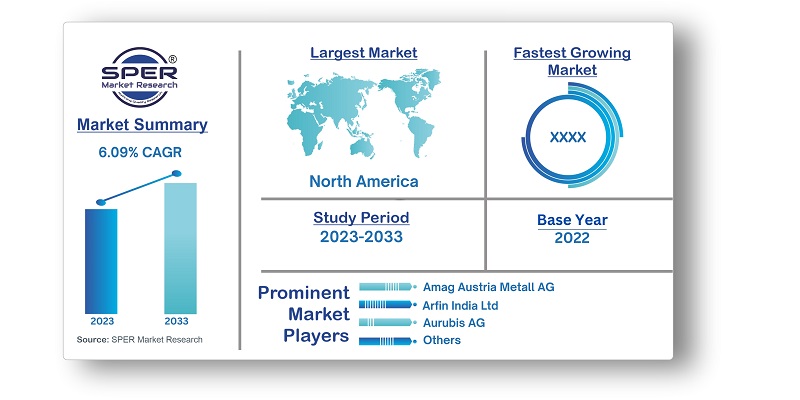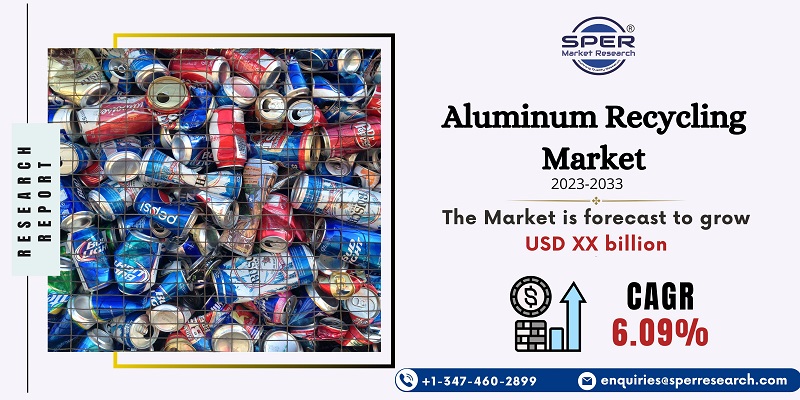
Aluminum Recycling Market Growth, Size, Trends, Revenue, Share, Challenges and Future Outlook
Aluminum Recycling Market- By Type, By End User- Regional Outlook, Competitive Strategies and Segment Forecast to 2033
| Published: Feb-2024 | Report ID: CHEM2415 | Pages: 1 - 227 | Formats*: |
| Category : Chemical & Materials | |||
- December 2023: The Company’s extremely low carbon footprint aluminum is quickly becoming a necessary product for businesses that emphasize sustainability goals in their supply chains. Rusal announced ambitions to begin using primary aluminum with the lowest carbon footprint in the world.
- August 2023: Sims Metal revealed intentions to buy the assets of Baltimore Scrap Corp (BSC), a metal recycler with headquarters in the United States, and its related companies. The transaction will be paid US$ 177 million in total consideration, plus working capital and other adjustments that will be decided at close.


| Report Metric | Details |
| Market size available for years | 2019-2033 |
| Base year considered | 2022 |
| Forecast period | 2023-2033 |
| Segments covered | By Type, By End User |
| Regions covered | North America, Asia-Pacific, Latin America, Middle East & Africa and Europe |
| Companies Covered | Amag Austria Metall AG , Arfin India Ltd. , Aurubis AG , Chalco Aluminum Corporation, Commercial Metals Company, Fervent Global LLP , Kuusakoski Recycling, Matalco Inc , Real Alloy, Sims Metal Management Ltd. |
- Automotive Industries
- Aerospace and Defence Industries
- Building and construction Industries
- Electrical and electronics Industries
- Packaging Industries
| By Type: |
|
| By End User: |
|
| By Region: |
|
- Global Aluminum Recycling Market Size (FY’2023-FY’2033)
- Overview of Global Aluminum Recycling Market
- Segmentation of Global Aluminum Recycling Market By Type (casting alloys, extrusion, sheet, and other types).
- Segmentation of Global Aluminum Recycling Market By End User (automotive, aerospace and defense, building and construction, electrical and electronics, packaging, and other end-user industries)
- Statistical Snap of Global Aluminum Recycling Market
- Expansion Analysis of Global Aluminum Recycling Market
- Problems and Obstacles in Global Aluminum Recycling Market
- Competitive Landscape in the Global Aluminum Recycling Market
- Impact of COVID-19 and Demonetization on Global Aluminum Recycling Market
- Details on Current Investment in Global Aluminum Recycling Market
- Competitive Analysis of Global Aluminum Recycling Market
- Prominent Players in the Global Aluminum Recycling Market
- SWOT Analysis of Global Aluminum Recycling Market
- Global Aluminum Recycling Market Outlook and Projections (FY’2023-FY’2033)
- Recommendations from Analyst
1.1. Scope of the report1.2. Market segment analysis
2.1. Research data source2.1.1. Secondary Data2.1.2. Primary Data2.1.3. SPER’s internal database2.1.4. Premium insight from KOL’s2.2. Market size estimation2.2.1. Top-down and Bottom-up approach2.3. Data triangulation
4.1. Driver, Restraint, Opportunity and Challenges analysis4.1.1. Drivers4.1.2. Restraints4.1.3. Opportunities4.1.4. Challenges4.2. COVID-19 Impacts of the Global Aluminum Recycling Market
5.1. SWOT Analysis
5.1.1. Strengths
5.1.2. Weaknesses5.1.3. Opportunities5.1.4. Threats5.2. PESTEL Analysis5.2.1. Political Landscape5.2.2. Economic Landscape5.2.3. Social Landscape5.2.4. Technological Landscape5.2.5. Environmental Landscape5.2.6. Legal Landscape5.3. PORTER’s Five Forces5.3.1. Bargaining power of suppliers5.3.2. Bargaining power of buyers5.3.3. Threat of Substitute5.3.4. Threat of new entrant5.3.5. Competitive rivalry5.4. Heat Map Analysis
6.1. Global Aluminum Recycling Market Manufacturing Base Distribution, Sales Area, Product Type6.2. Mergers & Acquisitions, Partnerships, Product Launch, and Collaboration in Global Aluminum Recycling Market
7.1. Global Aluminum Recycling Market Value Share and Forecast, By Type, 2023-20337.2. Casting Alloys7.3. Extrusion7.4. Sheet7.5. Other types
8.1. Global Aluminum Recycling Market Size Value Share and Forecast, By End User, 2023-20338.2. Aerospace and defence8.3. Automotive8.4. Building and construction8.5. Electrical and electronics8.6. Other end-user industries8.7. Packaging
9.1. Global Aluminum Recycling Market Size and Market Share
10.1. Global Aluminum Recycling Market Size and Market Share, By Type (2019-2026)10.2. Global Aluminum Recycling Market Size and Market Share, By Type (2027-2033)
11.1. Global Aluminum Recycling Market Size and Market Share, By End User (2019-2026)11.2. Global Aluminum Recycling Market Size and Market Share, By End User (2027-2033
12.1. Global Aluminum Recycling Market Size and Market Share, By Region (2019-2026)12.2. Global Aluminum Recycling Market Size and Market Share, By Region (2027-2033)12.3. Asia-Pacific12.3.1. Australia12.3.2. China12.3.3. India12.3.4. Japan12.3.5. South Korea12.3.6. Rest of Asia-Pacific12.4. Europe12.4.1. France12.4.2. Germany12.4.3. Italy12.4.4. Spain12.4.5. United Kingdom12.4.6. Rest of Europe12.5. Middle East and Africa12.5.1. Kingdom of Saudi Arabia12.5.2. United Arab Emirates12.5.3. Rest of Middle East & Africa12.6. North America12.6.1. Canada12.6.2. Mexico12.6.3. United States12.7. Latin America12.7.1. Argentina12.7.2. Brazil12.7.3. Rest of Latin America
13.1. Amag Austria Metall AG13.1.1. Company details13.1.2. Financial outlook13.1.3. Product summary13.1.4. Recent developments13.2. Arfin India Ltd13.2.1. Company details13.2.2. Financial outlook13.2.3. Product summary13.2.4. Recent developments13.3. Aurubis AG13.3.1. Company details13.3.2. Financial outlook13.3.3. Product summary13.3.4. Recent developments13.4. Chalco Aluminum Corporation13.4.1. Company details13.4.2. Financial outlook13.4.3. Product summary13.4.4. Recent developments13.5. Commercial Metals Company13.5.1. Company details13.5.2. Financial outlook13.5.3. Product summary13.5.4. Recent developments13.6. Fervent Global LLP13.6.1. Company details13.6.2. Financial outlook13.6.3. Product summary13.6.4. Recent developments13.7. Kuusakoski Recycling13.7.1. Company details13.7.2. Financial outlook13.7.3. Product summary13.7.4. Recent developments13.8. Matalco Inc13.8.1. Company details13.8.2. Financial outlook13.8.3. Product summary13.8.4. Recent developments13.9. Real Alloy13.9.1. Company details13.9.2. Financial outlook13.9.3. Product summary13.9.4. Recent developments13.10. Sims Metal Management Ltd.13.10.1. Company details13.10.2. Financial outlook13.10.3. Product summary13.10.4. Recent developments13.11. Others
SPER Market Research’s methodology uses great emphasis on primary research to ensure that the market intelligence insights are up to date, reliable and accurate. Primary interviews are done with players involved in each phase of a supply chain to analyze the market forecasting. The secondary research method is used to help you fully understand how the future markets and the spending patterns look likes.
The report is based on in-depth qualitative and quantitative analysis of the Product Market. The quantitative analysis involves the application of various projection and sampling techniques. The qualitative analysis involves primary interviews, surveys, and vendor briefings. The data gathered as a result of these processes are validated through experts opinion. Our research methodology entails an ideal mixture of primary and secondary initiatives.



Frequently Asked Questions About This Report
PLACE AN ORDER
Year End Discount
Sample Report
Pre-Purchase Inquiry
NEED CUSTOMIZATION?
Request CustomizationCALL OR EMAIL US
100% Secure Payment






Related Reports
Our Global Clients
Our data-driven insights have influenced the strategy of 200+ reputed companies across the globe.




















